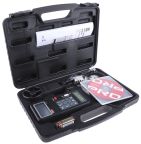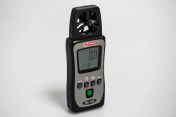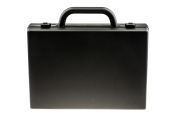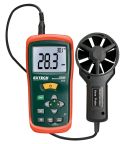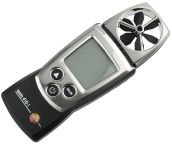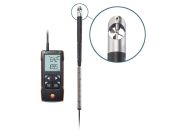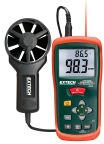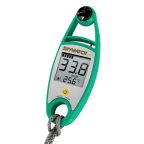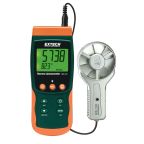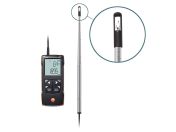Anemometers
An anemometer, also known as a wind speed meter or handheld wind meter, is a device used to measure wind or air velocity. Commonly found in weather stations, these instruments provide precise and reliable wind speed data essential for a variety of applications ranging from meteorology, to industrial airflow monitoring.
At RS, you can find several types of anemometers for sale, with various probe attachments and measurement parameters suitable for your application. Most handheld wind speed monitors are rugged and durable to withstand the elements that they may be presented with, as well as being weatherproof, especially those that can be mounted to measure over long periods of time.
How Does an Anemometer Work?
Anemometers measure wind speed by detecting the interaction between air movement and a sensing element. The most common anemometer types are:
- Cup and Propeller (Vane) Anemometers: These mechanical devices use rotating cups or blades that spin faster as wind speed increases. The rotation speed is converted into an electrical signal, which is then displayed digitally as wind velocity.
- Hot-Wire Anemometers: This anemometer uses a fine heated wire that reacts to air flow by changing its temperature. The cooling effect alters the wire’s electrical resistance, allowing the device to calculate wind speed based on the power needed to maintain the wire’s temperature.
- Ultrasonic Anemometers: These advanced devices measure wind speed by timing ultrasonic pulses between transducers, providing highly accurate, real-time data without moving parts.
Other specialised anemometer types include laser Doppler anemometers and pressure tube anemometers, which have specific medical, scientific and industrial applications.
Types of Anemometers
Anemometers come in various designs, each suited to different wind measurement applications. Understanding the principles of how they function and their unique features is crucial for selecting the right wind anemometer or handheld wind meter for your needs.
Cup Anemometers
Cup anemometers are among the simplest and most widely used wind speed meters. They consist of two to four hemispherical cups mounted on horizontal arms that rotate around a vertical shaft. The cups react to wind movement by spinning. The rotational speed is directly proportional to wind speed, which is then converted to a digital or analogue readout.
Vane (Propeller) Anemometers
Also called propeller or windmill anemometers, these devices feature a small fan or propeller aligned with the wind direction by a tail vane. The propeller’s rotational speed corresponds to wind velocity. Some handheld wind meters include a protective cage around the blades, making them highly portable and ideal for field work.
Hot-Wire Anemometers
A hot-wire anemometer measures wind speed based on the cooling effect of air flowing past a heated, fine wire (often tungsten or platinum). The power needed to maintain the hot wire at its temperature has a direct correlation with wind velocity.
Ultrasonic Anemometers
These high-precision anemometers calculate wind speed by measuring the time it takes for ultrasonic pulses to travel between transducers.
Pressure-Tube (Pitot Tube) Anemometers
These devices measure wind speed by detecting pressure differences created by airflow over a tube opening. The pressure differential is converted into wind velocity.
Thermal Anemometers with Velocity/Temperature Profiling
These compact sensors combine hot wire technology with temperature measurement. They are often used in wind tunnels, or electronics cooling studies to profile airflow velocity and temperature simultaneously.
When Would You Use an Anemometer?
Anemometers provide accurate and real-time measurements and give valuable insights into airflow patterns, evaluate environmental conditions, in order to help make informed decisions. These instruments are used in applications like:
- Weather monitoring and forecasting
- HVAC system installation and maintenance
- Environmental research and air quality studies
- Agricultural applications (e.g., crop dusting)
- Renewable energy site assessment (e.g., wind farms)
- Industrial ventilation and safety monitoring
- Wind velocity reporting for aviation and aeronautics
Digital vs Analogue Anemometers
Choosing between a digital anemometer or analogue anemometer? Let’s compare the two and see which one is suitable for you based on precision, ruggedness, cost, and data collected.
Digital Anemometers
Digital anemometers represent the modern standard for airflow measurement, relying on electronic sensing and processing for precise readouts.
- Precision and Functionality: They deliver highly accurate, numerical wind speed readings, eliminating subjective interpretation. Many include advanced features such as data logging, Bluetooth connectivity for remote monitoring, and integrated temperature or humidity sensors. This makes them ideal for tasks demanding high-fidelity data, like HVAC balancing, research, or environmental monitoring where a comprehensive wind speed meter is needed.
- Usability and Integration: The digital output is easy to read and seamlessly integrates with software for analysis and reporting, which is a significant advantage in industrial or research settings. This streamlined data flow is especially useful for a portable anemometer or handheld anemometer that needs to quickly capture and transfer data.
Analogue Anemometers
Analogue anemometers, while simpler, remain relevant in specific niches due to their inherent robustness and straightforward operation.
- Mechanical Displays and Ruggedness: These use mechanical displays, like dials or rotating indicators, to show wind speed. Their simpler construction makes them more rugged and less susceptible to electronic interference, making them suitable for harsh environments or basic, continuous outdoor monitoring where a simple wind anemometer is sufficient.
- Low-Maintenance Applications: Often requiring minimal or no external power, analogue anemometers are cost-effective for basic readings and applications where high precision isn't the primary concern. They are a suitable handheld wind meter for quick, approximate readings in the field.
Industrial Applications of Anemometers
Anemometers are indispensable tools across a multitude of industrial sectors, providing critical data for safety, efficiency, and regulatory compliance.
Here are some of their key industrial applications:
- HVAC Systems (Heating, Ventilation, and Air Conditioning): Professionals use digital anemometers to measure airflow in ducts, ensuring proper ventilation, system balancing, and energy efficiency in commercial and residential buildings. This ensures optimal indoor air quality and comfort.
- Meteorology and Weather Forecasting: Meteorological stations and researchers use wind anemometers extensively to measure wind speed and direction, crucial for weather prediction, climate studies, and understanding atmospheric phenomena.
- Aeronautics and Aviation: Anemometers are vital on airfields and for drone operations to assess wind conditions, assisting pilots with take-offs, landings, and flight planning for safety and performance. A handheld wind meter or portable anemometer can be essential for quick pre-flight checks.
- Renewable Energy (Wind Power): Wind farm developers and operators employ anemometers to assess site viability, optimise turbine placement, and monitor performance, maximising energy generation and operational efficiency.
- Mining and Tunnelling: Anemometers are used to monitor air circulation in mines and tunnels, ensuring adequate ventilation to disperse hazardous gases and maintain safe working conditions for personnel.
- Environmental Monitoring and Air Quality: These devices measure air currents to track pollutant dispersion, assist in wildfire management, and assess localised wind effects on ecosystems. A hot wire anemometer might be used for highly localised, sensitive airflow measurements.
- Agriculture: Farmers use anemometers to determine optimal conditions for spraying pesticides, irrigation, and preventing soil erosion, particularly in large-scale agricultural operations.
Leading Supplier and Distributor of Anemometers in Malaysia
RS is your go-to source for high-quality anemometers at competitive prices. When it comes to precision instruments from industry leaders, we make it a point to have ready stock. Explore our selection of digital anemometers, hot wire anemometers, and robust cup or vane wind anemometers for reliable air and wind speed meter solutions. Shop from reliable brands such as Extech, Kestrel, Testo and many more.
We also carry a comprehensive range of environmental test equipment, such as air quality monitors or hygrometers for your testing needs. For more details on our ordering process, delivery services, and delivery fees for your next order, please refer to our delivery page.
